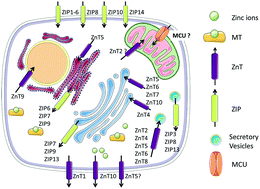Sensors for measuring subcellular zinc pools
Abstract
Zinc homeostasis is essential for normal cellular function, and defects in this process are associated with a number of diseases including type 2 diabetes (T2D), neurological disorders and cardiovascular disease. Thus, variants in the SLC30A8 gene, encoding the vesicular/granular zinc transporter ZnT8, are associated with altered insulin release and increased T2D risk while the zinc importer ZIP12 is implicated in pulmonary hypertension. In light of these, and findings in other diseases, recent efforts have focused on the development of refined sensors for intracellular free zinc ions that can be targeted to subcellular regions including the cytosol, endoplasmic reticulum (ER), secretory granules, Golgi apparatus, nucleus and the mitochondria. Here, we discuss recent advances in Zn2+ probe engineering and their applications to the measurement of labile subcellular zinc pools in different cell types.

- This article is part of the themed collection: Recent Review Articles


 Please wait while we load your content...
Please wait while we load your content...